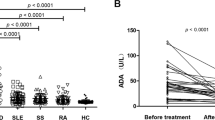Abstract
Anti-TNF-α agents are increasingly used in rheumatoid arthritis (RA) treatment and that is known to increase the risk of tuberculosis (TB) reactivation. Adenosine deaminase (ADA) levels are shown to increase to high levels in TB patients. Our aim is to investigate the serum ADA levels in RA patients being treated with anti-TNF-α and to compare the results with the patients on DMARD therapy. The study groups comprised of 56 RA patients (45 female, mean age 49) who were treated either with two or three DMARDs, 32 RA patients with anti-TNF-α treatment (26 female, mean age 46) and 20 healthy controls (10 female, mean age 48). All patients fulfilled the 1987 ACR criteria for RA. DAS28 score was calculated for all subjects. When compared to healthy controls, ADA levels were measured statistically higher both in patient groups (P = 0.046, 0.002). ADA levels in anti-TNF-α group were similar to conventional therapy (11.3 ± 2.7, 10.9 ± 4.01; P = 0.76). PPD was positive in 17 RA patients in the anti-TNF-α treatment group (%53). The ADA levels were found to be similar in the anti-TNF-α group when compared according to the PPD positivity (positive, 12.4 ± 3.7; negative, 10.5 ± 2.1; P = 0.02). No correlation was found between the ADA levels and age, disease duration, ESR, CRP, DAS 28 and HAQ score. In this study, we observed that RA patients at remission taking DMARD or anti-TNF-α therapy have similar levels of serum ADA. Although serum ADA levels during TB infection increase much higher, in our study, ADA levels of all RA patients were lower than 15 IU/L. Elevated ADA levels may be a clue for diagnosis of TB in patients who were on anti-TNF-α therapy.


Similar content being viewed by others
References
Iannone F, Corrigall VM, Kingsley GH et al (1994) Evidence for the continuous recruitment and activation of T cells into the joints of patients with rheumatoid arthritis. Eur J Immunol 24:2706–2713. doi:10.1002/eji.1830241120
Weisman MH (2002) What are the risks of biologic therapy in rheumatoid arthritis? An update on safety. J Rheumatol Suppl 65:33–38
Gardam MA, Keystone EC, Menzies R et al (2003) Anti-tumour necrosis factor agents and tuberculosis risk: mechanisms of action and clinical management. Lancet Infect Dis 3:148–155. doi:10.1016/S1473-3099(03)00545-0
Van der Weyden MB, Kelley WN (1976) Human adenosine deaminase distribution and properties. J Biol Chem 251:5448–5456
Dwivedi M, Misra SP, Misra V et al (1990) Value of adenosine deaminase estimation in the diagnosis of tuberculous ascites. Am J Gastroenterol 85:1123–1125
Mishra OP, Yusaf S, Ali Z et al (2000) Adenosine deaminase activity and lysozyme levels in children with tuberculosis. J Trop Pediatr 46:175–1788. doi:10.1093/tropej/46.3.175
Arnett FC, Edworthy SM, Bloch DA et al (1988) The American Rheumatism Association 1987 revised criteria for the classification of rheumatoid arthritis. Arthritis Rheum 31:315–324. doi:10.1002/art.1780310302
Giusti G (1974) Adenosine deaminase. In: Bergmeyer HU (ed) Methods of enzymatic analysis, 1st edn. Academic Press, New York, pp 1092–1099
American Thoracic Society (2000) Targeted tuberculin testing and treatment of latent tuberculosis infection. Am J Respir Crit Care Med 161:221–247
Winthrop KL (2006) Risk and prevention of tuberculosis and other serious opportunistic infections associated with the inhibition of tumor necrosis factor. Nat Clin Pract Rheumatol 2:602–610. doi:10.1038/ncprheum0336
Keane J, Gershon S, Wise RP et al (2001) Tuberculosis associated with infliximab, a tumor necrosis factor alpha-neutralizing agent. N Engl J Med 345:1098–1104. doi:10.1056/NEJMoa011110
Mohan AK, Coté TR, Block JA et al (2004) Tuberculosis following the use of etanercept, a tumor necrosis factor inhibitor. Clin Infect Dis 39:295–299. doi:10.1086/421494
FDA briefing document (2003) Update on the TNF-α blocking agents. In: Safety of TNF blocking agents. http://www.fda.gov/ohrms/docket/ac03/briefing/3930B1-01-B-TNF.Briefing.pdf. Accessed 15 September
Gopi A, Madhavan SM, Sharma SK et al (2007) Diagnosis and treatment of tuberculous pleural effusion in 2006. Chest 131:880–889. doi:10.1378/chest.06-2063
Lakshmi V, Rao RR, Joshi N et al (1992) Serum adenosine deaminase activity in bacillary or paucibacillary pulmonary tuberculosis. Indian J Pathol Microbiol 35:48–52
Kelbel C, Stumpf B, Schmidt W et al (1995) Role of serum adenosine deaminase as an immune parameter of tuberculosis. Pneumologie 49:684–688
Al-Shammary FJ (1997) Adenosine deaminase activity in serum and pleural effusions of tuberculous and non-tuberculous patients. Biochem Mol Biol Int 43:763–779
Tarhan G, Gumuslu F, Yilmaz N et al (2006) Serum adenosine deaminase enzyme and plasma platelet factor 4 activities in active pulmonary tuberculosis, HIV-seropositive subjects and cancer patients. J Infect 52:264–268. doi:10.1016/j.jinf.2005.06.009
Kuyucu N, Karakurt C, Bilaloglu E et al (1999) Adenosine deaminase in childhood pulmonary tuberculosis: diagnostic value in serum. J Trop Pediatr 45:245–247. doi:10.1093/tropej/45.4.245
Miossec P, van den Berg W (1997) Th1/Th2 cytokine balance in arthritis. Arthritis Rheum 40:2105–2115. doi:10.1002/art.1780401203
Sari RA, Taysi S, Yilmaz O et al (2003) Correlation of serum levels of adenosine deaminase activity and its isoenzymes with disease activity in rheumatoid arthritis. Clin Exp Rheumatol 21:87–90
Calis M, Ates F, Yazici C et al (2005) Adenosine deaminase enzyme levels, their relation with disease activity, and the effect of colchicine on adenosine deaminase levels in patients with Behcet’s disease. Rheumatol Int 25:452–456. doi:10.1007/s00296-005-0612-z
Hitoglou S, Hatzistilianou M, Gougoustamou D et al (2001) Adenosine deaminase activity and its isoenzyme pattern in patients with juvenile rheumatoid arthritis and systemic lupus erythematosus. Clin Rheumatol 20:411–416. doi:10.1007/s100670170005
Meunier P, Filipe P, Emerit I et al (1995) Adenosine deaminase in progressive systemic sclerosis. Acta Derm Venereol 75:297–299
Author information
Authors and Affiliations
Corresponding author
Rights and permissions
About this article
Cite this article
Erer, B., Yilmaz, G., Yilmaz, F.M. et al. Assessment of adenosine deaminase levels in rheumatoid arthritis patients receiving anti-TNF-α therapy. Rheumatol Int 29, 651–654 (2009). https://doi.org/10.1007/s00296-008-0750-1
Received:
Accepted:
Published:
Issue Date:
DOI: https://doi.org/10.1007/s00296-008-0750-1




